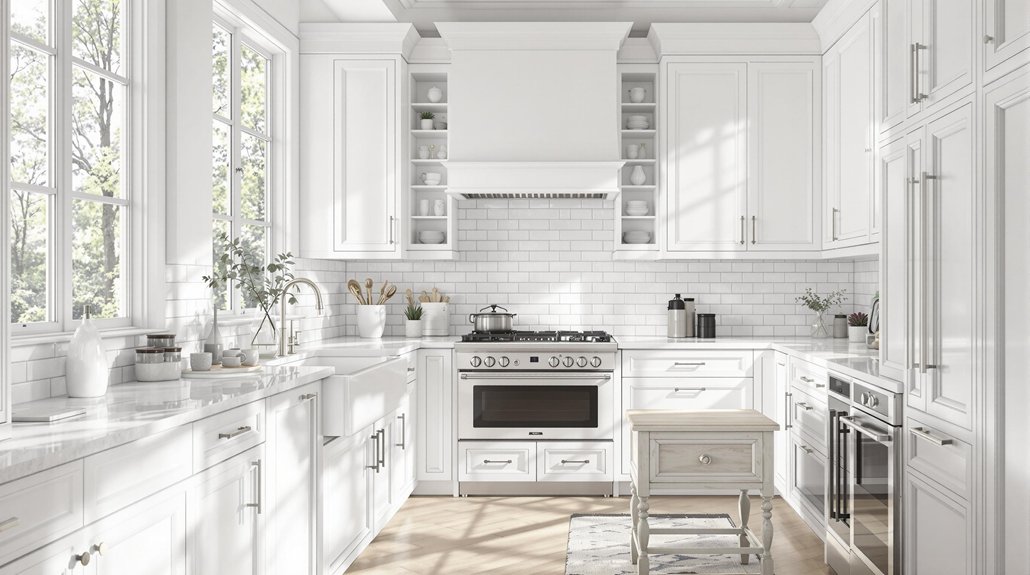
20 White Kitchen Cabinet Ideas That Are Clean and Classic
White kitchen cabinets deliver enduring sophistication with styles like cozy cottage charm, high-contrast pairings, and modern minimalist allure. Options range from classic shaker doors and glossy seamless finishes to bold statement hardware and vibrant artisanal backsplash tiles. Pairing white cabinetry with Carrara marble, black granite, or rustic wood enhances depth, while open shelving and strategic color accents update the look. Meticulously restored period details or glamorous metallic touches further personalize the space—explore further for twenty inspiring, clean, and classic ideas.
Key Takeaways
- Pair crisp white cabinets with matte black hardware for a timeless, high-contrast look that feels both classic and modern.
- Incorporate glossy finishes on white cabinets to reflect light and visually expand small kitchen spaces.
- Add natural wood open shelving or seating to soften white cabinetry and introduce warmth and texture.
- Use hand-painted backsplash tiles or vintage-inspired hardware to infuse white kitchens with artisanal charm and historical detail.
- Opt for minimalist, seamless white cabinetry with hidden storage for a clean, uncluttered, and elegant appearance.
Cozy Cottage Charm
Evoking the nostalgic appeal of early 20th-century interiors, cozy cottage kitchens utilize white cabinetry to amplify light and cultivate a sense of openness. White cabinets form the visual foundation, reflecting available daylight and enhancing the space’s airy quality. This deliberate palette choice supports the homey, inviting ambiance intrinsic to cottage design.
Integrating a fresh blue ceiling, such as Silvery Blue by Benjamin Moore, introduces gentle chromatic contrast without diminishing the prominence of white cabinets. Hand-painted backsplash tiles impart artisanal character, ensuring visual intrigue within the restrained color scheme.
The interplay of white cabinetry with rustic finishes and tactile natural textures—such as exposed wood beams or stone flooring—preserves authenticity and boosts functionality. Collectively, these elements establish a welcoming, practical environment ideal for communal cooking and gathering.
High Contrast Pairings
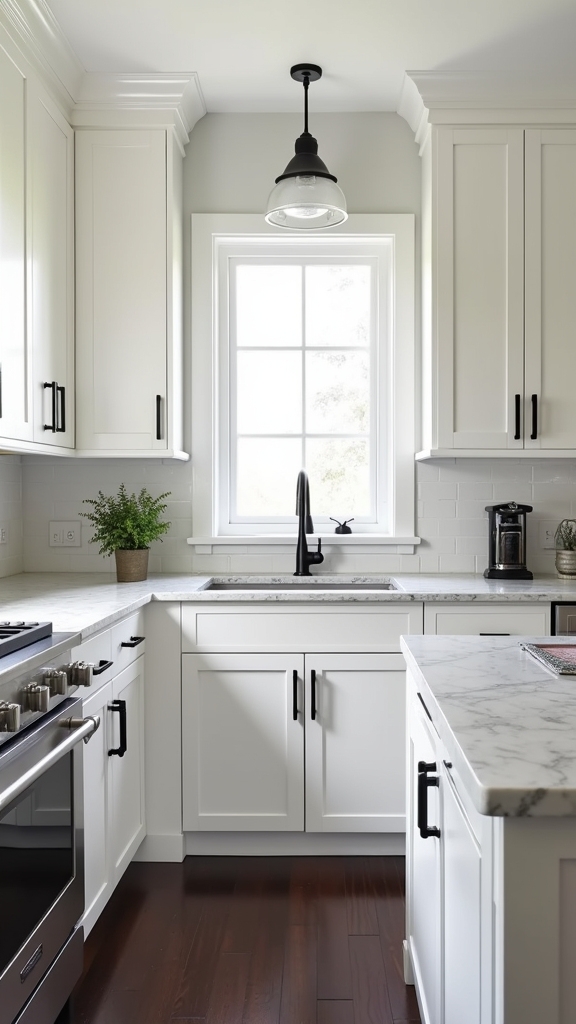
When executed with careful balance, high contrast pairings in kitchen design—such as crisp white cabinetry juxtaposed against deep black elements—deliver immediate visual impact and architectural clarity. This approach accentuates the clean lines and geometric forms central to modern kitchens. Black cabinetry with white countertops, or a charcoal hood above pristine cabinets, creates dramatic depth and draws the eye. Functional considerations include maintenance advantages, as darker surfaces effectively conceal stains. Designers often introduce tactile variation by pairing matte black hardware with high-gloss white cabinets to intensify visual intrigue. The integration of luxurious materials, like Carrara marble or glossy black tiles, maintains the kitchen’s sophisticated yet clean profile. Additionally, incorporating natural and strategically placed recessed lighting can improve both the functionality and aesthetics of the kitchen space.
| Feature | High Contrast Example |
|---|---|
| Cabinetry & Countertops | Black cabinets, white tops |
| Hardware Finish | Matte black pulls |
| Backsplash Material | Glossy black tile |
| Range Hood | Charcoal above white cabinets |
| Surface Texture | Gloss vs. matte |
Minimalist Allure
Minimalist allure in white kitchens is achieved through sleek, seamless surfaces that reinforce a sense of visual continuity.
A subtle neutral palette complements this streamlined approach, while hidden storage solutions maintain an uncluttered environment.
Together, these elements optimize both form and function for an enhanced, modern aesthetic.
Sleek Seamless Surfaces
Although often understated, sleek seamless surfaces in white kitchens command attention through their refined simplicity and functional elegance. High-gloss cabinetry finishes reflect ambient light, amplifying brightness while ensuring low-maintenance durability—ideal for culinary spaces demanding both form and function.
Integrated appliances are expertly concealed within cabinetry, eliminating visual interruptions and reinforcing a streamlined minimalist profile. Uniform white surfaces, such as quartz or marble countertops, synchronize with cabinetry, establishing an unbroken visual flow that enhances spatial perception and cleanliness.
The incorporation of hidden handles or push-to-open mechanisms eradicates the need for protruding hardware, preserving the purity of clean lines central to contemporary minimalist design. This approach in white kitchens not only maximizes openness and airiness but also enhances the everyday cooking experience with effortless sophistication.
Subtle Neutral Palette
By layering white cabinetry with subtle gradients of off-white, light gray, and beige, a kitchen achieves a nuanced minimalist allure that feels both serene and visually dynamic.
The subtle neutral palette extends the visual field, allowing white cabinets to serve as a crisp anchor while gentle tonal variations add architectural depth.
Integration of natural materials—such as pale wood accents and honed stone countertops—introduces tactile warmth and understated texture, enhancing the palette without overpowering the minimalist ethos.
Light-reflective surfaces, including glossy tiles or polished metals, amplify natural light, imbuing the kitchen with a sense of openness and freshness.
Discreet botanical elements or soft-toned décor can punctuate the scheme, fostering vibrancy while sustaining the overall tranquil, clean aesthetic inherent to a subtle neutral palette.
Hidden Storage Solutions
When concealed storage solutions are integrated into white kitchen designs, the result is a visually uninterrupted space where the cabinetry’s pristine surfaces remain the focal point.
Hidden storage solutions are pivotal in achieving minimalist allure, as they eliminate countertop clutter and uphold the clean aesthetic intrinsic to white kitchens. High-efficiency storage is realized through expertly engineered cabinetry that prioritizes both organization and discretion, guaranteeing that every utensil and appliance is easily accessible yet out of sight.
The following elements exemplify functional innovation in hidden storage solutions:
- Pull-out shelves and drawers maximize utility within sleek cabinetry.
- Toe-kick drawers provide discreet space for infrequently used items.
- Integrated compartments guarantee systematic storage of utensils and small appliances.
- Concealed appliance garages hide gadgets for a streamlined appearance.
- Seamless cabinetry maintains the all-white, uninterrupted design.
Glamorous Touches
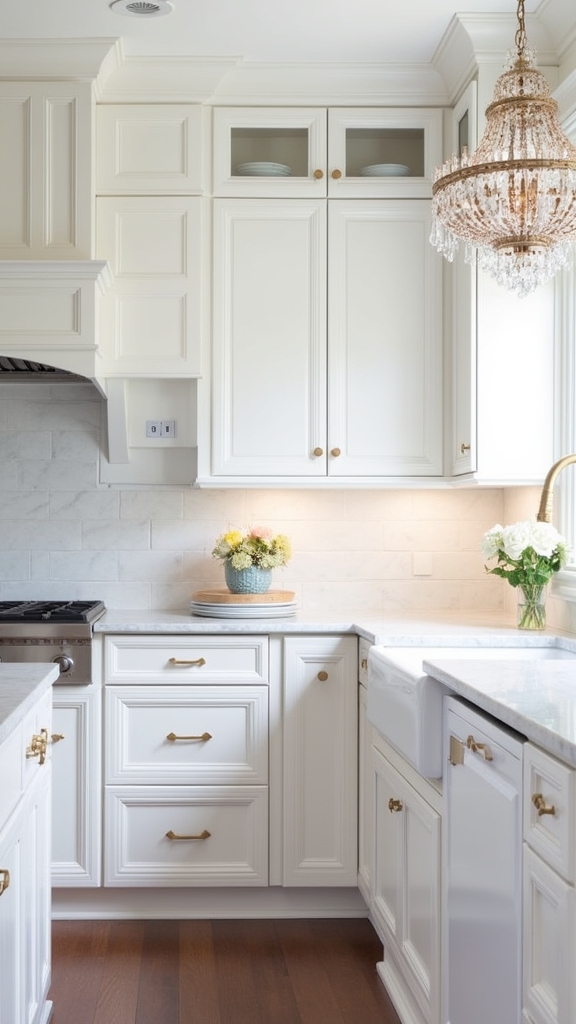
Luxe materials and contrasting finishes serve as the foundation for glamorous touches in white kitchen cabinet design. Incorporating high-contrast marble elements, such as a Carrara marble island, introduces a chic layering effect that instantly enhances the visual richness of the cabinetry. Bold black accents—whether through cabinetry, hardware, or fixtures—provide dynamic visual interest and a sophisticated edge to an all-white palette. The interplay between glossy and matte surfaces, like a high-gloss backsplash juxtaposed with matte black appliances, amplifies the kitchen’s elegance and tactile appeal. Metallic hardware in gold or brass imparts a glamorous touch while delivering a warm counterpoint to the cool undertones of white cabinetry. Decorative features, including vintage light fixtures or custom cabinetry, further reinforce a timeless yet opulent aesthetic. Light greige tones can foster a calming and inviting environment in the kitchen, enhancing mood and productivity through thoughtful color choices.
Original Details
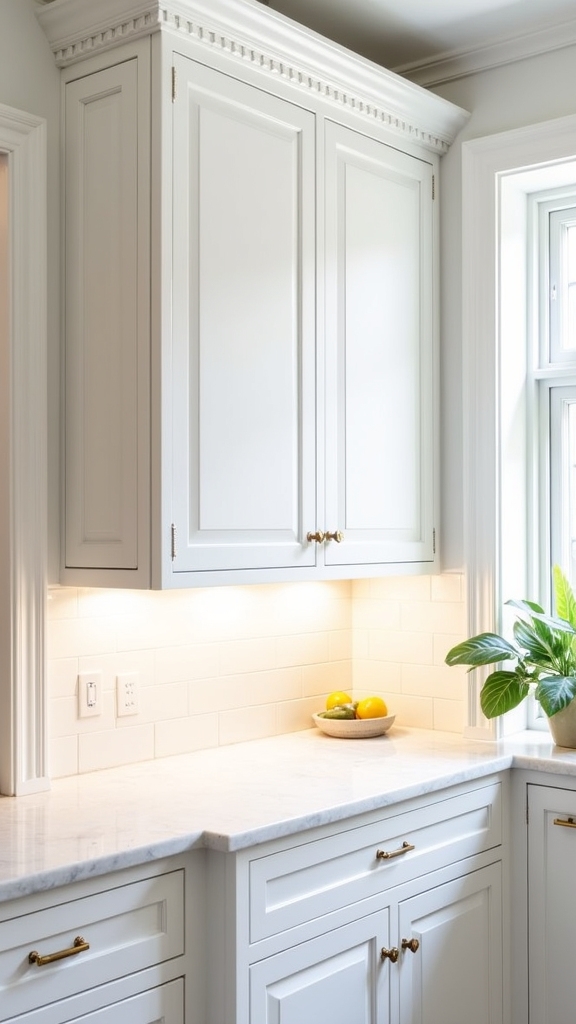
Preserving vintage cabinetry in a white kitchen highlights authentic craftsmanship and historic value, elevating both visual and tactile interest. Restoring period hardware—such as original brass pulls or porcelain knobs—reinforces design continuity and functional durability. Celebrating architectural features like crown molding or transom windows guarantees the space maintains character while optimizing natural light and proportion. Integrating vintage hardware like brass or copper pulls with worn finishes can enhance the retro aesthetic, adding a sense of historical integrity to your kitchen design.
Preserving Vintage Cabinetry
While trends in kitchen design evolve, maintaining the original details of vintage cabinetry—such as intricate moldings and distinctive hardware—ensures the space retains its historical character.
Preservation demands a nuanced approach that balances visual authenticity with modern functionality. A subtle white wash accentuates the patina of vintage cabinetry, enhancing both form and utility.
Expertly applied custom finishes, like a delicate glaze, emphasize the cabinetry’s craftsmanship without compromising its period essence. Integrating authentic period furnishings or fixtures further unifies the kitchen’s aesthetic, creating a harmonious and inviting environment.
Restoration techniques, such as careful sanding and refinishing, are essential for rejuvenating surfaces while safeguarding historical integrity.
- Highlight intricate moldings with a soft white palette
- Apply light glazes for depth and dimension
- Preserve distinctive hardware for authenticity
- Integrate period-appropriate furnishings
- Employ gentle restoration methods
Restoring Period Hardware
Beyond the careful preservation of vintage cabinetry, attention to period hardware becomes a defining element in achieving authentic white kitchen design. Restoring period hardware—such as ornate hinges, vintage knobs, and decorative drawer pulls—elevates historical integrity while providing visual contrast against crisp, modern cabinets.
Expert restoration involves gentle cleaning, eco-friendly products, and refinishing techniques that safeguard original patina and guarantee continued functionality. Polishing brass fittings or retouching chipped enamel allows these unique components to reclaim their status as focal points within the space.
Integrating restored hardware into a white kitchen not only preserves craftsmanship but also introduces tactile and visual richness. The result is a harmonious blend of tradition and innovation, reinforcing the kitchen’s narrative through thoughtfully retained and enhanced original details.
Celebrating Architectural Features
Architectural features such as original moldings, exposed beams, and distinctive window casings become visual anchors in a white kitchen, enhancing both historical context and spatial clarity.
White cabinets serve as an understated backdrop, amplifying the impact of these heritage details by offering contrast and cohesion. The strategic use of a white palette guarantees that intricate paneling and decorative trims are highlighted, not hidden, preserving the home’s unique character.
Integrating elements like glass-front cabinet doors further emphasizes period-specific decor, allowing vintage dishware to contribute to the kitchen’s narrative. Balancing original flooring or a vintage stove with white cabinetry marries modern cleanliness with enduring charm.
- Highlight decorative moldings with crisp white cabinetry
- Showcase beams with ceiling-height cabinets
- Frame unique windows using seamless white finishes
- Display vintage dishware in glass-front cabinets
- Pair original flooring with contemporary white cabinets
Mediterranean Inspiration
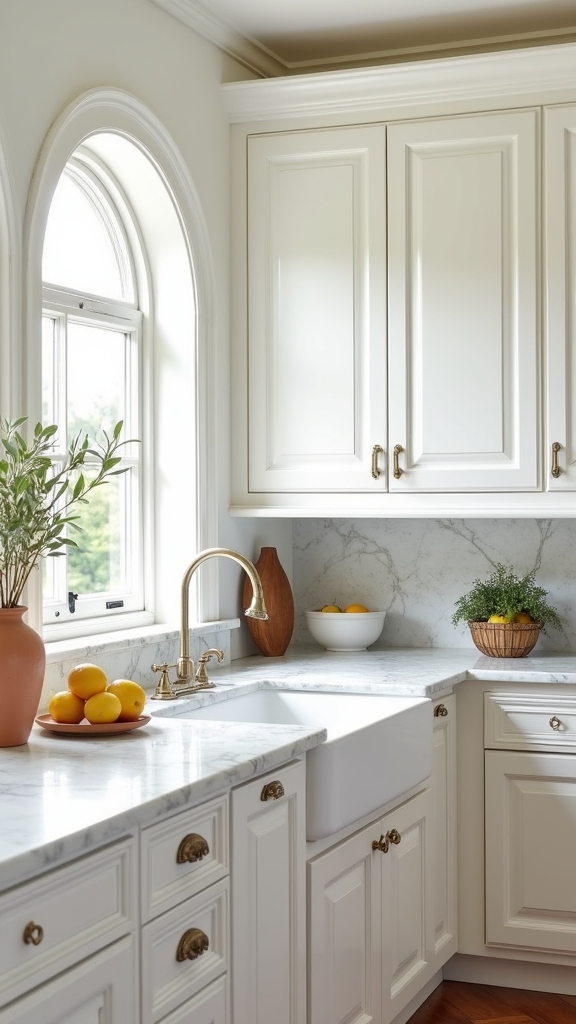
Evoking the timeless allure of southern European design, a Mediterranean-inspired white kitchen merges traditional craftsmanship with functional elegance. White cabinets form the visual backbone, washed in harmonious tones that amplify natural light and honor historic detailing. Original cabinetry, paired with classic wall tiles, creates a cohesive backdrop, while bold wall trim introduces architectural depth and accentuates the kitchen’s airy character. Incorporating a vintage O’Keefe & Merritt stove infuses rustic authenticity, complemented by terracotta or reclaimed wood flooring that anchors the space with tactile warmth. Botanical prints—in upholstery or decorative accents—reference organic Mediterranean beauty and invite a subtle interplay with the crisp cabinetry. Reclaimed wood can also be used in cabinetry and flooring to enhance cohesion and provide warmth and authenticity.
| Element | Mediterranean Feature | Functional Impact |
|---|---|---|
| Cabinetry | White, traditional | Brightens, unifies space |
| Flooring | Terracotta/reclaimed wood | Grounds, adds texture |
| Decorative Detail | Botanical prints | Softens, introduces nature |
Timeless Farmhouse Style
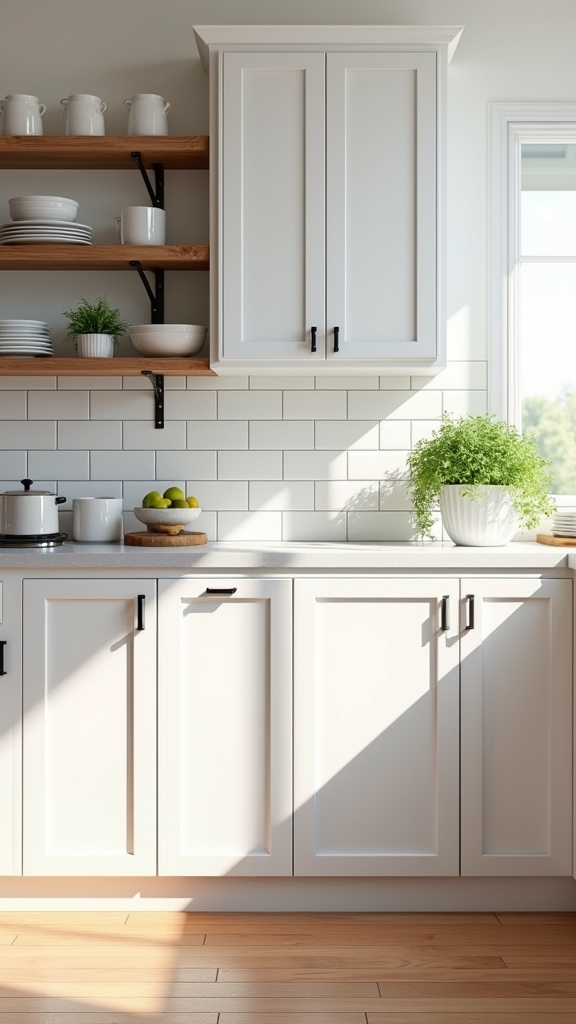
When integrated into a kitchen, timeless farmhouse style leverages white cabinets as a luminous foundation, emphasizing clean lines and understated elegance.
White kitchen cabinets serve as an adaptable backdrop, harmonizing with rustic and vintage elements to create a welcoming yet sophisticated environment.
Open wood shelving paired with white cabinetry fosters a sense of openness, while farmhouse sinks introduce both aesthetic charm and practical utility.
Matte black hardware punctuates the simplicity of white kitchen cabinets, offering a subtle contemporary edge.
Incorporating natural materials and textural accents further enhances the farmhouse ambiance.
- Open wood shelving for airy storage and visual warmth
- Farmhouse sinks combined with white kitchen cabinets for functional appeal
- Matte black hardware for modern contrast
- Reclaimed wood and vintage fixtures to enhance authenticity
- Shiplap ceilings complemented by recessed or pendant lighting for contemporary appeal
Small Space Solutions
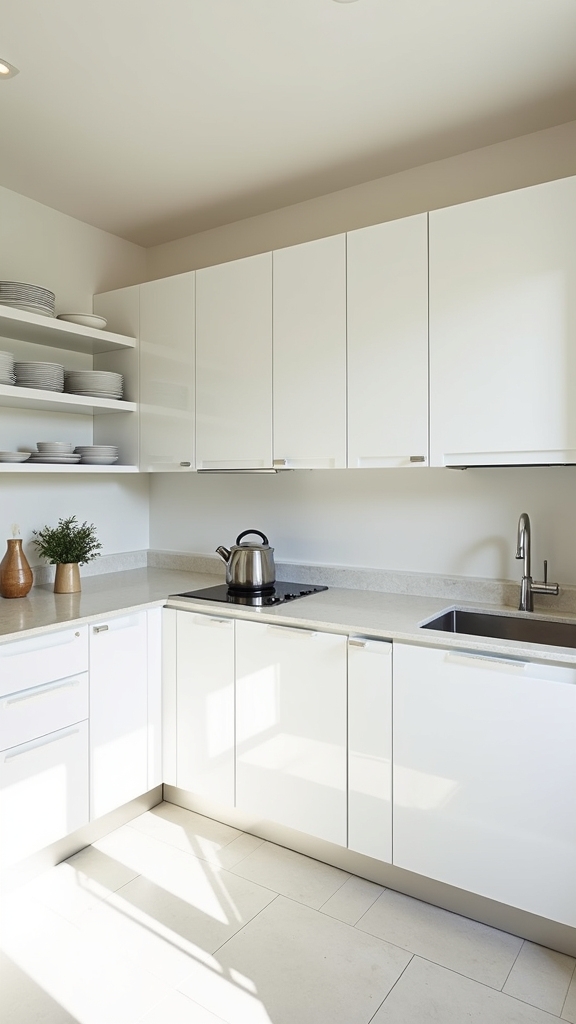
Optimizing small kitchens begins with maximizing vertical storage through floor-to-ceiling white cabinetry, effectively utilizing every inch while maintaining a streamlined profile. Light-reflecting finishes, such as high-gloss lacquers and mirrored backsplashes, amplify natural light and visually expand the space. This combination delivers both enhanced functionality and a luminous, open atmosphere critical for compact layouts. Additionally, incorporating multi-functional appliances can further optimize space by combining various features into one unit, enhancing both the efficiency and style of the kitchen.
Maximizing Vertical Storage
Thoughtful vertical storage solutions are essential for maximizing functionality in compact white kitchens. Employing vertical space not only increases storage capacity but also maintains the clean, classic aesthetic that white cabinetry offers.
Expertly designed layouts prioritize maximizing vertical storage through streamlined organization and visual clarity. Open shelving above countertops provides a practical method for keeping everyday essentials accessible while contributing to the kitchen’s overall design language.
Tall cabinets that extend to the ceiling eliminate wasted space and minimize countertop clutter, enhancing the perception of openness and order.
- Open shelving above counters for accessible storage and visual depth
- Floor-to-ceiling cabinetry to optimize vertical storage potential
- Wall-mounted hooks or magnetic strips for pots, pans, and utensils
- Decorative baskets on upper shelves for infrequently used items
- Rolling ladder or step stool for safe, convenient access to high storage
Light-Reflecting Finishes
Beyond vertical storage strategies, the implementation of light-reflecting finishes further enhances the spatial dynamics of white kitchens—particularly in compact footprints.
High-gloss cabinetry and glossy tile backsplashes act as optical amplifiers, effectively dispersing available light throughout the room. These light-reflecting finishes maximize natural illumination, cultivating an airy, expansive ambiance that belies the kitchen’s true dimensions.
Strategically positioned, such surfaces emphasize architectural features and introduce visual interest without crowding the limited square footage. When juxtaposed with darker elements—such as contrasting countertops or flooring—these finishes generate depth and direct visual flow.
Additionally, materials with a shiny finish offer a pragmatic advantage: their smooth, nonporous surfaces resist stains and scuffs, streamlining maintenance while preserving a pristine, modern aesthetic in even the busiest small-scale kitchens.
Trend-Forward Designs
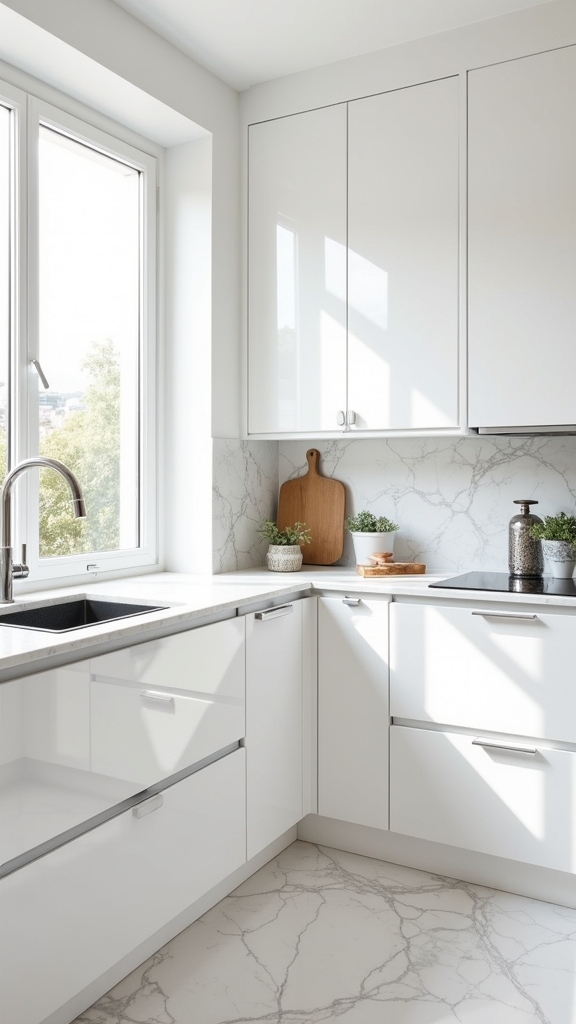
How do today’s white kitchens achieve both modernity and warmth? The answer lies in a strategic blend of materials, finishes, and contrasts that raise the timeless appeal of white cabinets.
Design experts increasingly leverage high-contrast details and organic textures to guarantee white kitchens remain visually dynamic and inviting without losing their crisp, clean essence. Functional elements are balanced with aesthetic choices, maximizing both utility and contemporary sophistication.
- High-contrast accents: Black hardware or dark countertops punctuate white cabinets, offering a bold, graphic edge.
- Layered whites: Combining bright white cabinets with off-white backsplashes introduces subtle depth and visual interest.
- Natural materials: Integration of wood or stone infuses warmth and aligns with biophilic design trends.
- Open shelving: Modern shelving options allow curated displays and break up solid cabinetry runs.
- Glossy finishes: Reflective cabinet surfaces amplify light and enhance spatial perception.
- Greige color schemes: The use of greige cabinets in a kitchen design can create an inviting environment that seamlessly blends with white elements for a balanced, timeless appeal.
Pops of Color
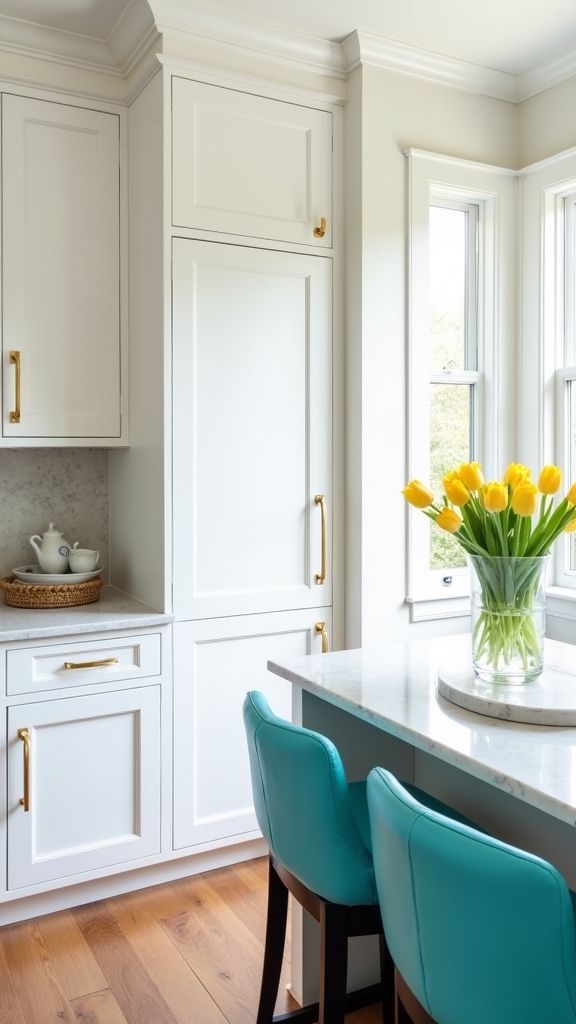
Pops of color serve as dynamic counterpoints within a largely white kitchen, introducing visual energy and personalized character. Expertly curated artwork, vibrant decor accents, and striking features like Portuguese Rosa marble shelving enhance spatial interest while preserving a clean, cohesive backdrop. These elements enable homeowners to strategically layer color for both functional distinction and aesthetic impact. Adding textured fabrics such as linen or cotton can complement the white kitchen cabinets, providing a soft contrast and enhancing the overall aesthetic.
Vibrant Artwork Accents
When vibrant artwork is introduced into a white kitchen, it establishes a striking visual contrast that enlivens the space without compromising its clean aesthetic.
Vibrant artwork accents—whether in the form of bold paintings or vivid prints—create a dynamic interplay against the backdrop of white cabinets, serving as both a focal point and a visual anchor.
Expertly curated pieces allow for tailored expression, infusing personality while maintaining the room’s uncluttered integrity.
The strategic placement of artwork supports cohesion with other kitchen elements, ensuring design harmony and functional flow.
- Select bold, colorful art to create a central focal point.
- Harmonize artwork hues with existing accent pieces for unity.
- Favor frameless or minimalist frames to preserve a sleek profile.
- Position art at eye level for maximum visual impact.
- Rotate artwork seasonally for continual freshness.
Colorful Decor Elements
A white kitchen serves as an ideal canvas for strategically placed colorful decor elements, allowing vibrant hues to punctuate the space without disrupting its clean, cohesive aesthetic. By utilizing a white-on-beige palette, designers can seamlessly introduce colorful decor elements such as bold backsplashes, vibrant kitchenware, or lively custom shelves crafted from materials like Portuguese Rosa marble. The integration of brightly colored barstools further enhances both functionality and visual interest, serving as dynamic focal points. Strategic placement of these accents maintains balance and prevents visual clutter, ensuring the timeless appeal of white cabinetry remains the centerpiece. This expert approach emphasizes both high-impact aesthetics and spatial harmony.
| Decor Element | Functional Benefit |
|---|---|
| Vibrant barstools | Adds seating, visual focus |
| Colored kitchenware | Everyday use, accent color |
| Bold backsplashes | Easy-clean, design contrast |
| Custom marble shelves | Storage, texture, color |
| Decorative accessories | Seasonal, flexible updates |
Energetic Marble Features
Marble, renowned for its dynamic veining and chromatic diversity, introduces an energetic dimension to white kitchen cabinetry through thoughtfully curated accents.
Through utilizing energetic marble features, designers infuse vibrancy and sophistication into a classic white palette without compromising its timeless appeal.
Integrating color-rich marble—like Portuguese Rosa marble—creates visual interest and enhances the overall mood.
Strategic placement of colorful marble elements and coordinated accessories results in a balanced yet animated aesthetic.
- Install a Portuguese Rosa marble shelf for a singular, luminous statement.
- Opt for multi-patterned marble tiles on countertops or floors to energize the space.
- Use boldly colored marble backsplashes to create striking visual contrast.
- Incorporate marble with playful hues to reflect individual style.
- Complement marble accents with brightly colored barstools or dishware for cohesive vibrancy.
Playful Pigments
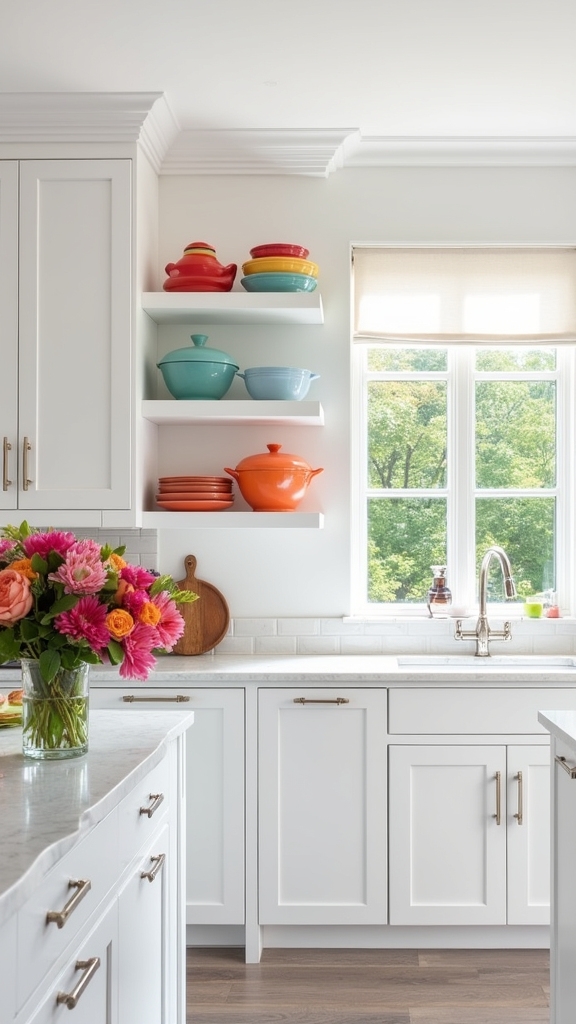
Many white kitchens benefit from strategic injections of playful pigments, where vibrant barstools, patterned backsplashes, or colorful accessories animate the space without compromising its timeless elegance. The inherent neutrality of white cabinetry establishes a versatile canvas, allowing chromatic accents to take center stage. Introducing a colorful backsplash, such as geometric tilework or bold mosaics, creates a focal point and imbues the kitchen with contemporary character. Artwork—particularly statement pieces like those from Jean Cocteau—offers an artful juxtaposition, delivering visual intrigue through saturated hues. Functionally, playful pigments can be employed through easily changeable décor, such as utensils, vases, or textiles, ensuring adaptability. This approach infuses personality while maintaining a cohesive, uncluttered environment, exemplifying how color can invigorate classic white kitchens through intentional, curated choices. Incorporating elements like gold fixtures and accents can enhance the overall luxury of the design, serving as striking focal points against the neutral backdrop.
Natural Wood Accents

While vivid accents energize white kitchens, the integration of natural wood introduces warmth and tactile contrast that grounds the space.
Natural wood accents, ranging from subtle trim to substantial countertops, create a harmonious interplay with white cabinetry—especially when bathed in natural light. This dynamic juxtaposition enhances visual interest while maintaining a clean, classic aesthetic.
Wood species such as oak or walnut offer a spectrum of tones, each contributing unique texture and depth. Reclaimed or distressed finishes add storied character, enhancing both modern and rustic sensibilities.
The strategic use of natural wood elements maximizes function and form, resulting in environments that are both inviting and visually enduring.
- Light oak butcher block countertops
- Walnut cabinet hardware and trims
- Reclaimed wood ceiling beams
- Distressed wood paneling on kitchen islands
- Natural light amplifying wood grain textures
Greige cabinets with gold fixtures introduce an elegant, luxurious contrast, enhancing visual interest and creating a stylish haven.
Open Shelving Concepts
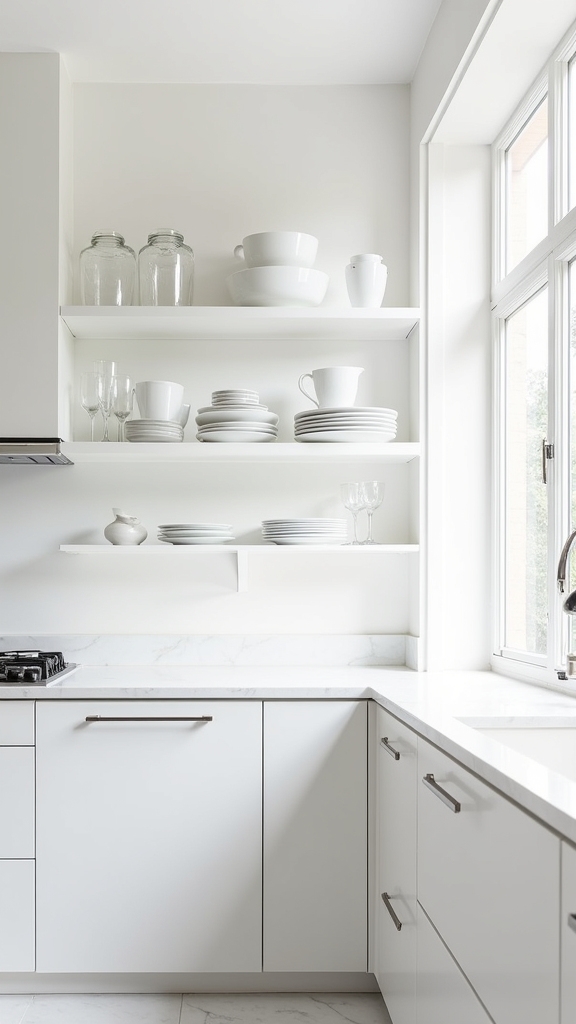
Versatility defines open shelving concepts within white kitchens, offering both visual openness and practical accessibility. Open shelves streamline day-to-day kitchen activity by enabling immediate access to frequently used dishware and utensils, eliminating the need for closed cabinetry.
Expert designers leverage open shelves to create curated displays, integrating decorative kitchenware and colorful dishes that enliven the minimalist palette of white cabinetry. Painting shelf interiors in vibrant hues introduces dynamic contrast and visual depth while maintaining the kitchen’s pristine essence.
Natural wood open shelves soften the overall aesthetic, balancing the crispness of white and fostering a welcoming atmosphere. Open shelving concepts not only maximize organizational efficiency but also empower homeowners to personalize their space, transforming utilitarian storage into a focal point that reflects individual style and taste.
Inviting Seating Options
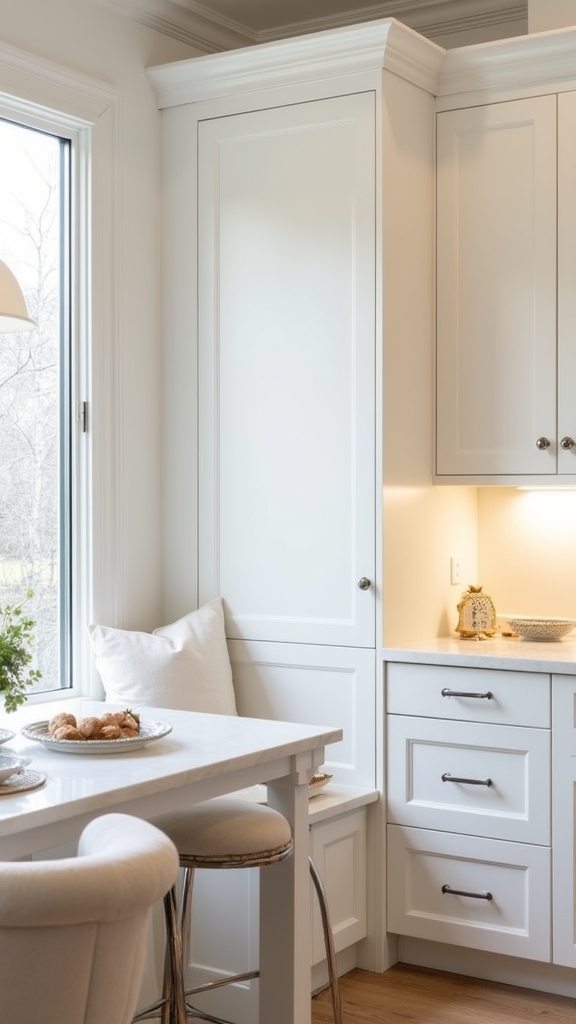
Integrating thoughtfully selected seating solutions can greatly improve the ambiance and functionality of a white kitchen. Inviting seating options not only increase comfort but also play a pivotal role in establishing a welcoming environment.
Strategic placement and material choice—such as natural wood finishes—introduce warmth and organic balance against the crisp backdrop of white cabinetry. Expertly curated seating, like Carl Malmsten stools or cozy breakfast nooks, encourages relaxation and fosters social interaction.
Mixing seating styles heightens visual interest and guarantees that the kitchen becomes a central hub for gatherings.
- Carl Malmsten stools infuse artisanal craftsmanship and tactile warmth.
- Upholstered breakfast nooks create an intimate, casual dining alcove.
- Natural wood finishes provide a harmonious, organic contrast.
- Mixed seating styles offer dynamic visual layering.
- Island-adjacent seating maximizes both social and functional utility.
Mix and Match Materials
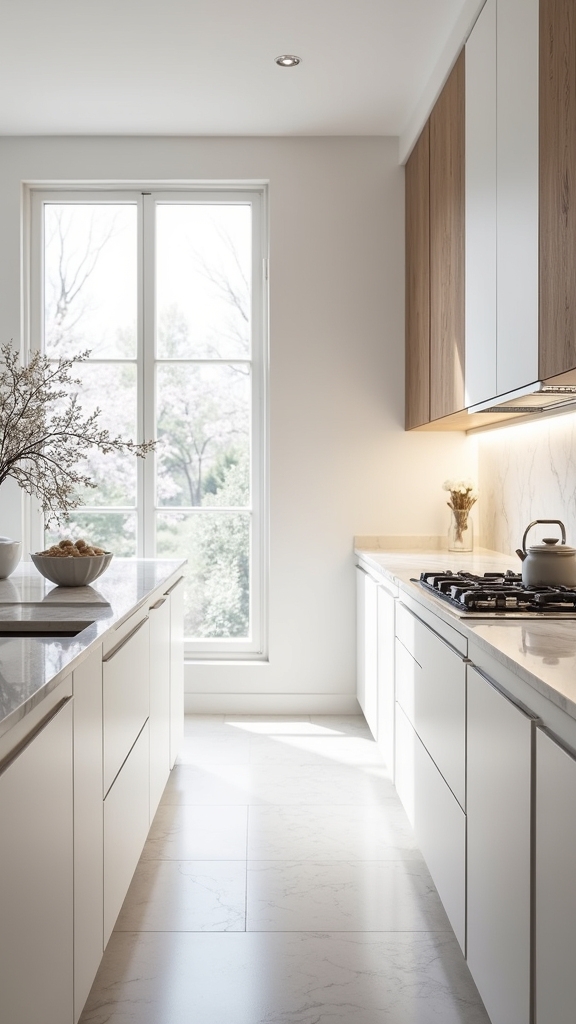
Beyond inviting seating arrangements, the interplay of mixed materials becomes a defining feature in a white kitchen’s design language.
Mixing materials—such as pairing crisp white cabinetry with textured wood accents—adds tactile warmth and visual complexity to an otherwise streamlined palette. The juxtaposition of high-gloss white cabinets with matte black or brushed metal hardware introduces striking contrast, reinforcing a modern aesthetic while maintaining functional durability.
Pairing white cabinetry with textured wood and contrasting hardware infuses warmth, depth, and modern sophistication into a minimalist kitchen palette.
Integrating ribbed wood surfaces alongside polished quartzite countertops brings dimensionality, enhancing spatial dynamism. The inclusion of natural stone, like Carrara marble, enhances sophistication and aligns with timeless design principles.
Employing a combination of glossy tiles against matte finishes strategically creates depth, ensuring that the kitchen remains visually engaging yet cohesive. Thoughtful mixing materials achieves both functional resilience and refined artistry.
Layered Shades of White
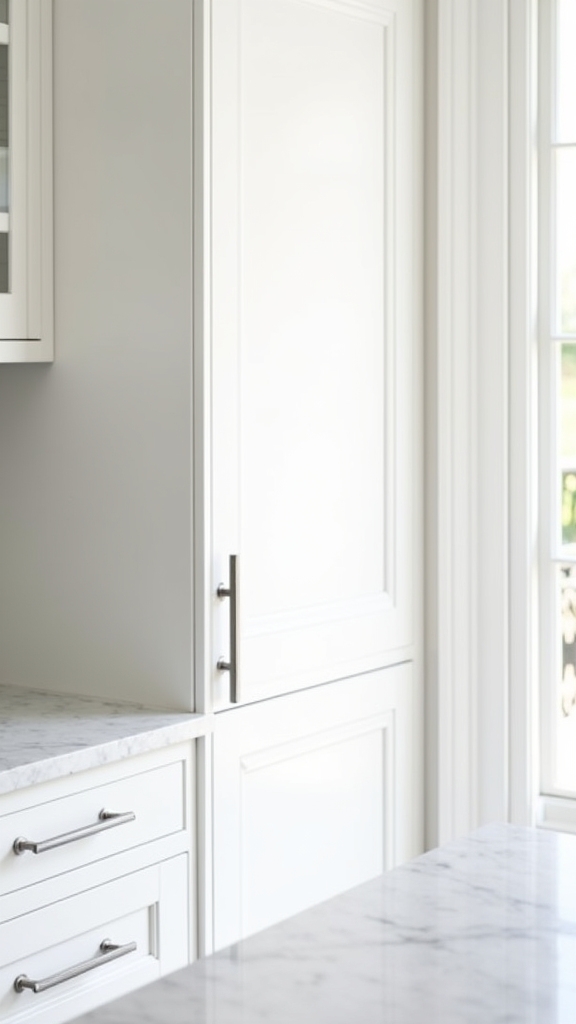
While white is often perceived as a singular hue, expert kitchen design leverages layered shades of white to introduce depth and nuanced visual interest.
By thoughtfully combining variations of white, designers achieve a space that feels both clean and multidimensional. For instance, pairing bright white cabinetry with light gray marble countertops establishes a sophisticated yet subtle contrast.
Warmer white backsplashes further enhance dimensionality and create gentle differentiation from cooler cabinet tones. The integration of wood accents—such as oak stools or shelving—injects warmth, ensuring a cohesive yet inviting atmosphere.
Varying the shades of white not only accentuates architectural details but also emphasizes textural contrasts for a curated aesthetic.
- Bright white cabinets with light gray marble
- Warm white backsplash for depth
- Oak elements for subtle warmth
- Contrasting cool and warm whites
- Highlighting architectural details
Bold Hardware Choices
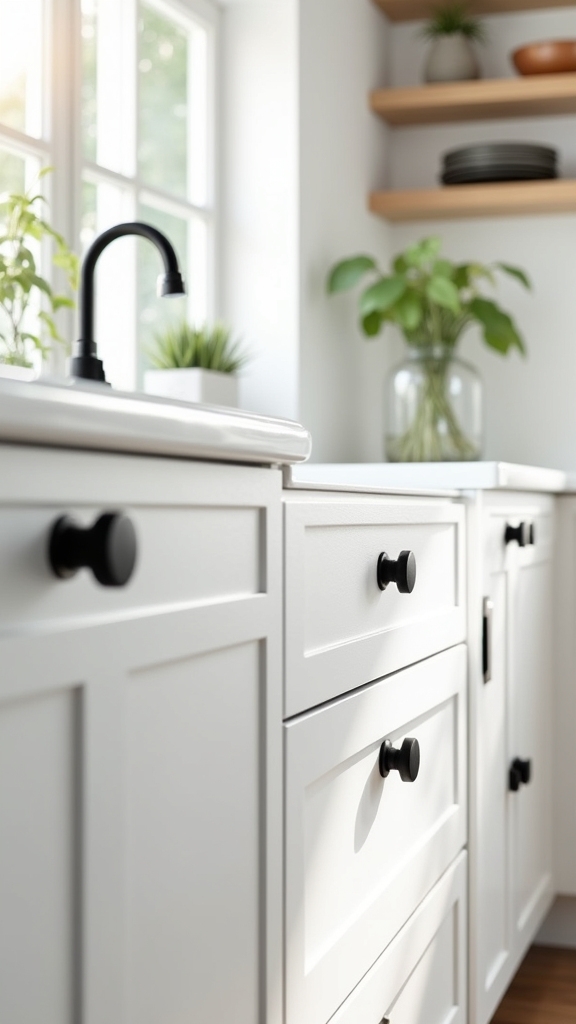
Strategic use of black hardware establishes a dramatic contrast against white cabinetry, reinforcing a modern visual anchor within the space.
Mixed metallic finishes—such as brass, chrome, or matte black—introduce layered depth and dynamic interplay of light across surfaces.
These bold selections not only enhance tactile functionality but also serve as defining visual statements in the kitchen’s overall composition.
Black Hardware for Contrast
A variety of bold hardware choices, particularly black hardware, deliver striking visual contrast against white kitchen cabinets, accentuating clean lines and architectural detail.
The interplay between crisp white surfaces and dark fixtures creates a visually dynamic focal point, elevating the kitchen’s aesthetic. Utilizing black hardware—especially in matte finishes—offers both versatility and timeless appeal, seamlessly integrating with styles ranging from modern minimalism to classic farmhouse.
Strategic selection of hardware shapes and sizes further customizes the cabinetry’s profile, enhancing both function and form.
- Black hardware underscores the geometric contours of white cabinet doors and drawers.
- Matte black finishes reduce glare and introduce tactile sophistication.
- Combining knobs and pulls in black generates visual rhythm and ergonomic accessibility.
- Black hardware anchors the lightness of all-white kitchens, imparting definition.
- Simple installation allows for an impactful, yet easily reversible, design upgrade.
Mixed Metallic Finishes
Integrating mixed metallic finishes into white kitchen cabinetry introduces layered visual complexity and sophisticated dimension.
Designers strategically pair elements such as brass hardware with stainless steel faucets, resulting in a curated interplay of warm and cool tones. The juxtaposition of matte and shiny metallics enhances depth and tactile interest, while bold hardware selections—oversized knobs or distinctive pulls in mixed metals—act as focal points, punctuating the clean lines of classic white cabinetry.
This approach not only infuses luxury but also encourages personalization, enabling homeowners to imprint their style preferences while maintaining a cohesive visual theme.
For best effect, experts recommend balancing the palette; harmonizing rich brass with cooler silvers ensures a seamless, elegant blend, elevating both the functional and aesthetic value of the kitchen environment.
Vibrant Backsplash Ideas
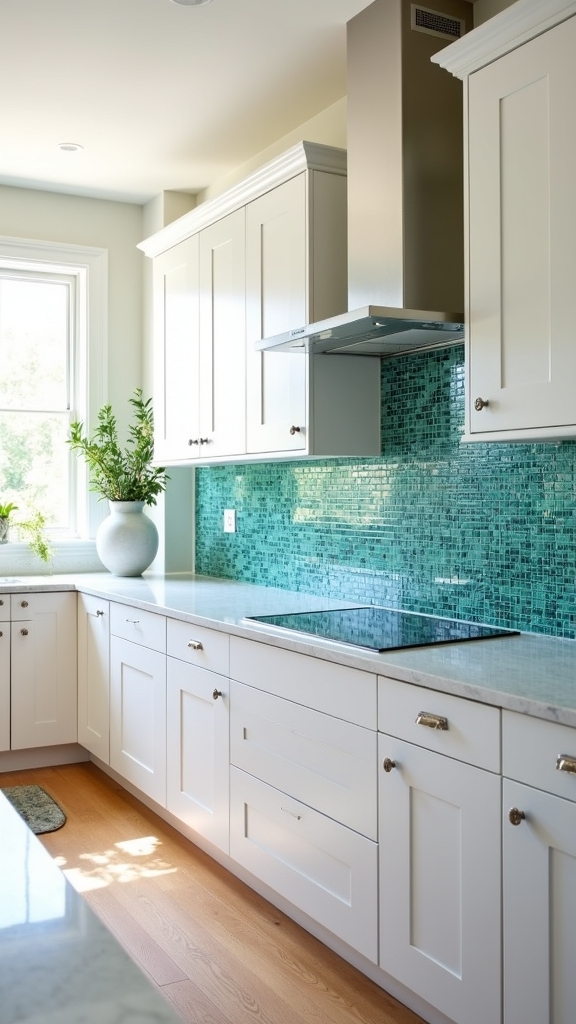
Countless kitchens with white cabinetry benefit from a vibrant backsplash, which injects color and dimension into the space while establishing a distinctive visual anchor.
Vibrant backsplashes introduce contrast, depth, and a sense of curated design intent. Expertly selected patterns and hues—ranging from bold ceramics to luminescent glass tiles—elevate the minimalist backdrop of white cabinets, ensuring both functional resilience and aesthetic appeal.
Vibrant backsplashes bring depth and artistry to white kitchens, transforming simple cabinetry with color, pattern, and luminous texture.
Designers often utilize strategic tile placement and color selection to manipulate light, define zones, or express personality within a classic framework.
- Colorful ceramic tiles enliven neutral cabinetry with dynamic focal points.
- Herringbone or mosaic tile arrangements create intricate visual interest.
- Glass tile backsplashes amplify light, enhancing spatial openness.
- Black-and-white geometric tiles deliver a crisp, modern edge.
- Custom backsplashes in vivid hues inject personality and energy.
Stone Countertop Pairings
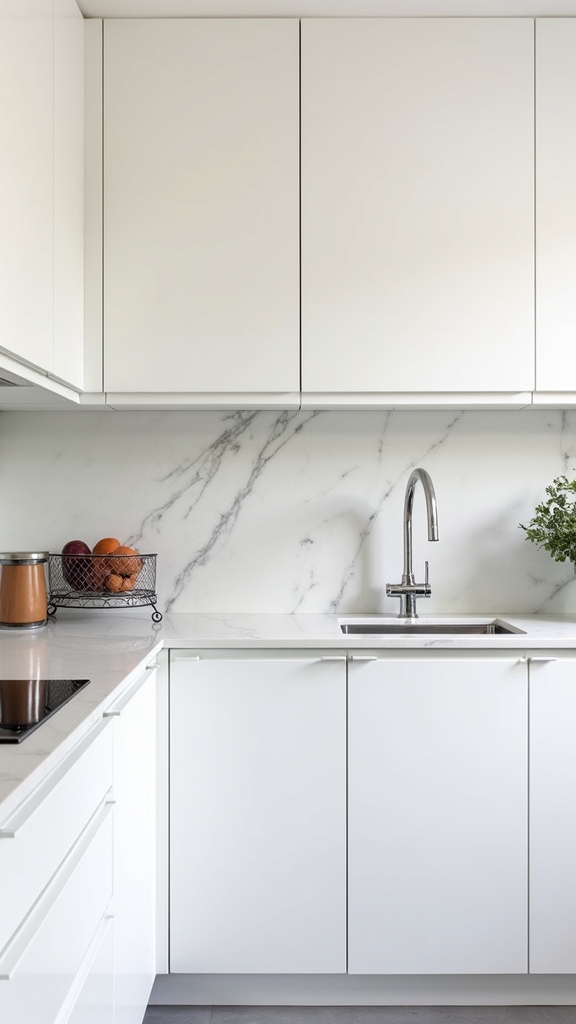
While white kitchen cabinets serve as a versatile canvas, stone countertop pairings define the room’s tone through materiality, texture, and contrast.
Selecting Carrara marble introduces a refined, luminous surface with subtle veining, reinforcing a timeless synergy with white cabinetry.
For dramatic visual impact, black granite stone countertops deliver bold contrast, anchoring the space in modern sophistication.
Soapstone, known for its tactile smoothness and organic veining, harmonizes understated elegance with functional durability beside white cabinets.
Quartz stone countertops in muted shades such as light gray or beige supply a cohesive, inviting warmth, integrating seamlessly with the cabinetry’s palette.
Precision in undertone alignment between stone countertops and cabinet whites is essential, ensuring continuity and an enhanced, balanced kitchen aesthetic without visual discord.
Modern Glossy Finishes
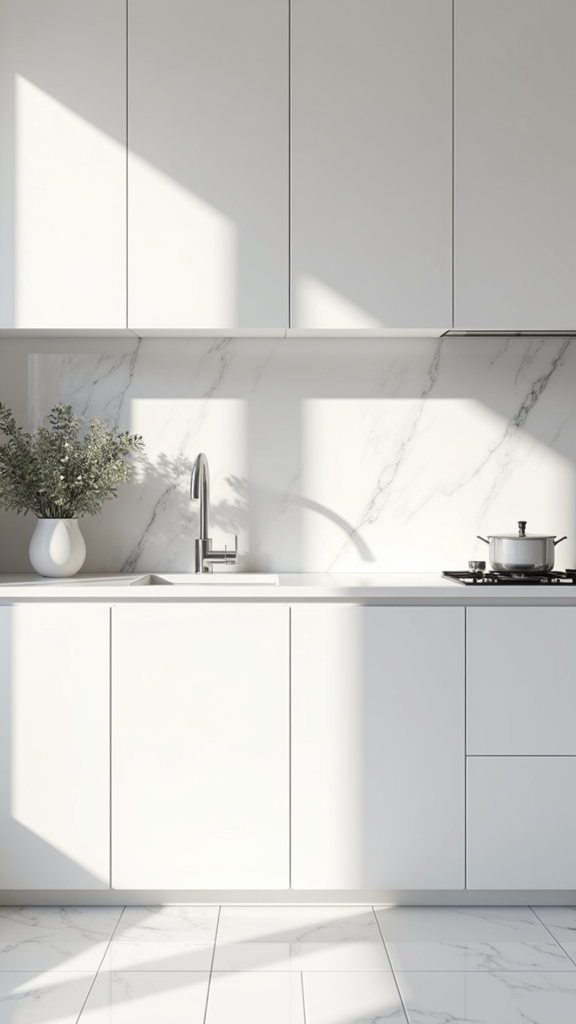
A multitude of contemporary kitchens utilize high-gloss white cabinets to maximize spatial brightness and visual expansiveness.
This surface treatment, particularly when applied to MDF or plywood substrates and finished with a robust lacquer, offers a seamless, streamlined look that resonates with both modern farmhouse and urban design sensibilities.
The reflective quality not only amplifies natural and artificial light but also enhances the presence of bold backsplashes and distinctive flooring.
Its luminous surface magnifies both light and design elements, making statement backsplashes and unique flooring truly stand out.
Homeowners value the durability and low maintenance of these finishes, which only require mild soap and water for upkeep.
Modern glossy cabinetry is adaptable, supporting a range of color palettes while maintaining a crisp, clean aesthetic.
- Reflects ambient light to enlarge perceived space
- Optimizes compatibility with modern farmhouse elements
- Enhances accent features like backsplashes and flooring
- Durable lacquer resists wear and simplifies cleaning
- Versatile color and finish options for tailored design
Frequently Asked Questions
What Looks Best With White Kitchen Cabinets?
Ideal visual impact with white kitchen cabinets is achieved by integrating contrast colors, such as bold black hardware. Accentuating with natural wood textures, vibrant backsplashes, and stone countertops enhances functionality, while mixed finishes introduce depth and sophisticated, cohesive aesthetics.
What Is the Most Timeless Kitchen Cabinet Style?
When evaluating timeless Cabinet Design, experts consistently highlight the shaker style. Its signature five-piece door construction, minimal ornamentation, and functional geometry offer enduring visual appeal and adaptability, ensuring it remains relevant regardless of evolving kitchen aesthetics and trends.
How Do You Make White Cabinets Look Vintage?
To create a vintage look, designers recommend integrating Vintage Accents like distressed finishes, antiqued hardware, and beadboard paneling. Utilizing creamy hues, glass-front doors, and open shelving enhances visual authenticity, while maintaining essential functionality and classic kitchen appeal.
What Is the Most Popular Color White for Kitchen Cabinets?
Among cabinet finishes, bright white remains the predominant choice for kitchen cabinets. Benjamin Moore’s “Chantilly Lace” and Sherwin-Williams’ “Pure White” are frequently specified for their luminous, high-reflective quality, providing both visual clarity and functional enhancement in kitchen environments.
Conclusion
White kitchen cabinets remain a timeless choice, seamlessly adapting to diverse design sensibilities. From cozy cottage charm to striking high-contrast pairings, their versatility enhances both spatial perception and light reflection. Integrating bold hardware, vibrant backsplashes, or luxurious stone countertops boosts functionality and visual impact. Whether opting for minimalist lines or glamorous accents, these twenty ideas demonstrate that white cabinetry offers enduring appeal and practical flexibility, forming a pristine foundation for personalized, high-performing kitchen environments.
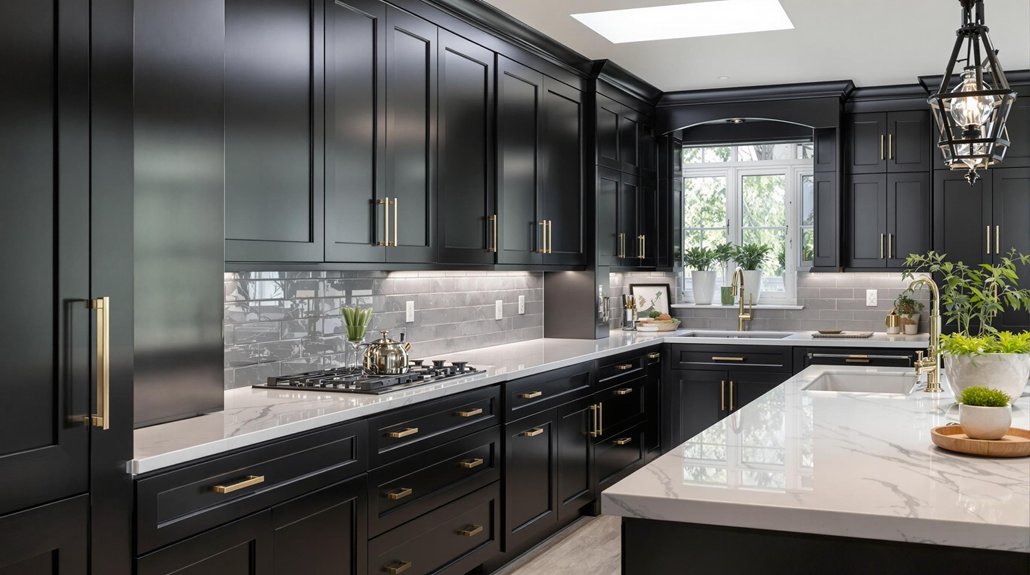
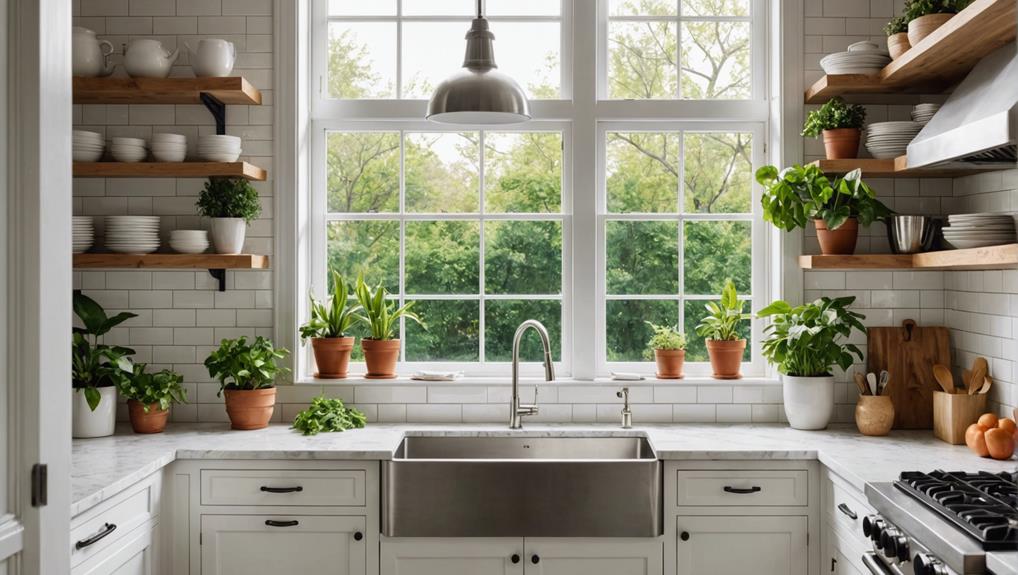
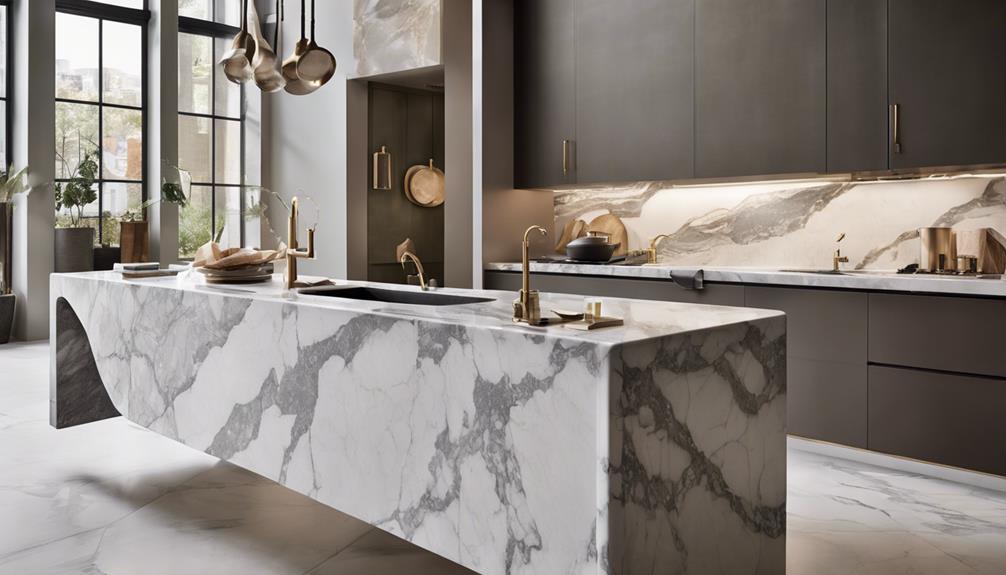
Leave a Reply